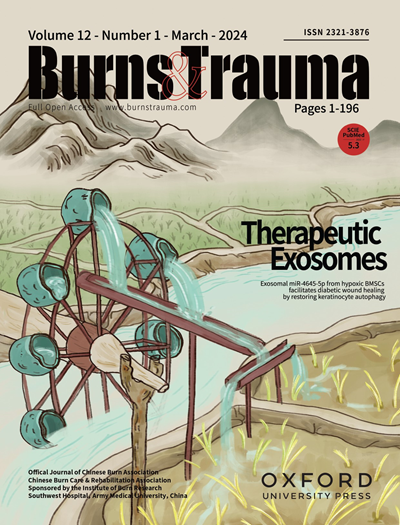神经调节在皮肤创面愈合中的作用的最新进展
IF 9.6
1区 医学
Q1 DERMATOLOGY
引用次数: 0
摘要
皮肤伤口愈合过程中的神经调节涉及神经系统和复杂的组织修复过程之间复杂的相互作用。皮肤是人体最大的器官,它依靠一个复杂的神经系统来控制对损伤的反应。最近的研究强调了神经调节在最大化伤口愈合结果中的关键作用。最近,研究人员还解释了在伤口愈合的不同阶段,周围神经系统和皮肤细胞之间的相互接触。神经递质和神经肽,曾经被认为是简单的信号分子,后来被认为是炎症、血管生成和细胞增殖的有效调节剂。在糖尿病患者和胎儿皮肤的再生能力中观察到的延迟伤口愈合强调了皮肤神经支配和神经调节剂的重要性。胎儿皮肤再生受神经调节环境、未成熟的免疫系统、丰富的生长因子和细胞多能性增强的影响。胎儿皮肤细胞表现出更大的灵活性和特化的细胞类型,细胞外基质成分促进再生。胎儿皮肤的细胞外基质成分促进再生,使其比成人皮肤更有能力,因为神经调节信号影响皮肤再生。对这些系统的了解可以促进治疗策略的发展,以改变皮肤的神经供应,以增强伤口愈合的过程。神经调节作为促进皮肤伤口修复的潜在治疗策略正在被探索。生物电子策略和神经调节技术可以操纵神经信号,优化神经免疫轴,调节炎症。本文综述了皮肤神经支配在伤口愈合中的作用,强调了感觉神经纤维和自主神经纤维释放的神经肽的重要性。本文讨论了与神经调节及其对皮肤伤口愈合的影响有关的重大发现。本文章由计算机程序翻译,如有差异,请以英文原文为准。
Recent advances in the role of neuroregulation in skin wound healing
Neuroregulation during skin wound healing involves complex interactions between the nervous system and intricate tissue repair processes. The skin, the largest organ, depends on a complex system of nerves to manage responses to injury. Recent research has emphasized the crucial role of neuroregulation in maximizing wound healing outcomes. Recently, researchers have also explained the interactive contact between the peripheral nervous system and skin cells during the different phases of wound healing. Neurotransmitters and neuropeptides, once observed as simple signalling molecules, have since been recognized as effective regulators of inflammation, angiogenesis, and cell proliferation. The significance of skin innervation and neuromodulators is underscored by the delayed wound healing observed in patients with diabetes and the regenerative capabilities of foetal skin. Foetal skin regeneration is influenced by the neuroregulatory environment, immature immune system, abundant growth factors, and increased pluripotency of cells. Foetal skin cells exhibit greater flexibility and specialized cell types, and the extracellular matrix composition promotes regeneration. The extracellular matrix composition of foetal skin promotes regeneration, making it more capable than adult skin because neuroregulatory signals affect skin regeneration. The understanding of these systems can facilitate the development of therapeutic strategies to alter the nerve supply to the skin to enhance the process of wound healing. Neuroregulation is being explored as a potential therapeutic strategy for enhancing skin wound repair. Bioelectronic strategies and neuromodulation techniques can manipulate neural signalling, optimize the neuroimmune axis, and modulate inflammation. This review describes the function of skin innervation in wound healing, emphasizing the importance of neuropeptides released by sensory and autonomic nerve fibres. This article discusses significant discoveries related to neuroregulation and its impact on skin wound healing.
求助全文
通过发布文献求助,成功后即可免费获取论文全文。
去求助
来源期刊

Burns & Trauma
医学-皮肤病学
CiteScore
8.40
自引率
9.40%
发文量
186
审稿时长
6 weeks
期刊介绍:
The first open access journal in the field of burns and trauma injury in the Asia-Pacific region, Burns & Trauma publishes the latest developments in basic, clinical and translational research in the field. With a special focus on prevention, clinical treatment and basic research, the journal welcomes submissions in various aspects of biomaterials, tissue engineering, stem cells, critical care, immunobiology, skin transplantation, and the prevention and regeneration of burns and trauma injuries. With an expert Editorial Board and a team of dedicated scientific editors, the journal enjoys a large readership and is supported by Southwest Hospital, which covers authors'' article processing charges.
 求助内容:
求助内容: 应助结果提醒方式:
应助结果提醒方式:


